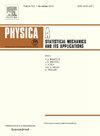Dynamics of sexually transmitted diseases with multi-pathway transmission and sex-based contact patterns
IF 2.8
3区 物理与天体物理
Q2 PHYSICS, MULTIDISCIPLINARY
Physica A: Statistical Mechanics and its Applications
Pub Date : 2025-01-15
DOI:10.1016/j.physa.2024.130273
引用次数: 0
Abstract
Sexually transmitted diseases (STDs) are a significant public health concern. Although their propagation has garnered extensive scientific attention, previous research rarely considers the multiple transmission pathways of STDs within sexual contact networks featuring different group interaction patterns. In this paper, we introduce a generalized SEIR model on a double-layer interconnected network to represent the diverse transmission pathways of STDs, including vertical and sexual contact routes, as well as the complexities of sex- and status-based contact patterns, such as same-sex contact, opposite-sex contact, and latent period transmission. We present rigorous results on the basic reproduction number and the global stability of equilibria, specifically showing that the system cannot undergo a Hopf bifurcation. Our theoretical and sensitivity analysis of quantifies the impact of related parameters on STD dynamics. This analysis reveals a strong dependence of on the internal structure of the female and male layers, as well as the connections between these layers. Both same-sex and opposite-sex transmission rates affect , but due to mutual reactions within a layer, changes in same-sex transmission parameters can have a more pronounced effect when contact patterns are equivalent. Our results even extend beyond STDs to address how sex-specific influences on individual behaviors contribute to differences in risk of other types of transmissions. We also propose and evaluate epidemic control strategies, discovering that isolation tracking and targeted immunization are particularly effective in controlling disease spread. Numerical simulations on both empirical and synthetic complex networks support and enhance our theoretical findings. Finally, we apply our framework to HIV transmission, highlighting the critical role of condom use in combating the virus.
求助全文
约1分钟内获得全文
求助全文
来源期刊
CiteScore
7.20
自引率
9.10%
发文量
852
审稿时长
6.6 months
期刊介绍:
Physica A: Statistical Mechanics and its Applications
Recognized by the European Physical Society
Physica A publishes research in the field of statistical mechanics and its applications.
Statistical mechanics sets out to explain the behaviour of macroscopic systems by studying the statistical properties of their microscopic constituents.
Applications of the techniques of statistical mechanics are widespread, and include: applications to physical systems such as solids, liquids and gases; applications to chemical and biological systems (colloids, interfaces, complex fluids, polymers and biopolymers, cell physics); and other interdisciplinary applications to for instance biological, economical and sociological systems.

 求助内容:
求助内容: 应助结果提醒方式:
应助结果提醒方式:


